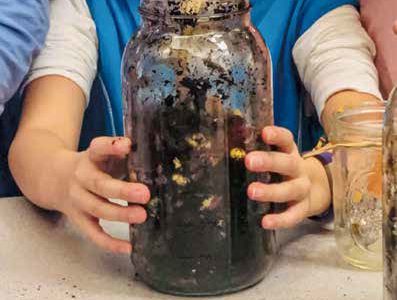
Last week, we introduced the young Helping Ninjas, Leo and Layla from Carmel, IN. They teach local kids in after-school programs how composting works by having them make take-home, mini compost bins in glass jars. It is a fun way to learn about composting and watch it in action.
This is a great activity to do this fall (especially around Halloween!) because you can use chopped up pumpkin parts (minus the seeds) as the vegetable scraps. Make sure to add soil to introduce decomposer microorganisms (tiny creatures including bacteria and fungi) that help break down the food scraps to make compost. Here are instructions, based on their compost project, for making your own composting jar at home.
What you need for each jar:
• 1 large (1-liter) empty mason or other large jar OR the bottom half of a 2-liter soda bottle
• 1 empty paper towel tube, cut into 1″ pieces (can use 2 empty toilet paper tubes or half of a cardboard egg carton instead)
• 1 cup of vegetable or fruit scraps (leftover bits of items that would normally get thrown away)
• 1 cup of brown leaves
• ¼ cup of soil (dirt from the ground or packaged potting soil)
• ½ cup of water
• spoon for mixing
Directions:
In a large jar, add the cut-up cardboard, vegetable or fruit scraps, dry leaves, and soil. Stir or place the lid on and shake. Add water. Stir or shake. Take the lid off. Place the jar on the kitchen counter or near a windowsill and watch the food scraps become compost! Continue to stir the jar once or twice a week. Add a tablespoon or two of water each week if the mixture looks dry.
It takes about four weeks for the mixture to become compost. You will know the compost is ready when the mixture looks like soil. The smaller the food scraps, the faster the mix is broken down to become compost. Once it is ready, add it to your garden or flower beds or use it to give a boost to indoor plants.
NOTE: Never add these to a compost pile: dairy products, like milk and cheese; anything that came from an animal, like meat or bones; pet waste; or fats. These items attract pests and make the compost stink.
Photo courtesy of Lindsey Berry of Helping Ninjas
